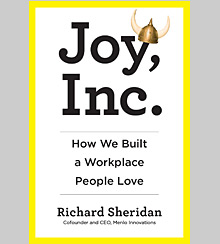Babes at Work
Bruce Poon Tip, author of Looptail: How One Company Changed the World by Reinventing Business, introduces a passage from Richard Sheridan’s Joy, Inc.: How We Built a Workplace People Love on how to build an employee-centric corporate culture.
Unconventional business practices and policies often seem crazy at first, but as I can attest from my experience at G Adventures, these ideas sometimes turn out to be terrific. Take the idea of allowing, even encouraging, employees to bring their babies to the office—as described in the excerpt below from Joy, Inc., a new book by Richard Sheridan, the cofounder and CEO of Menlo Innovations.
Sure, bringing their babies to work solves a major problem for new parents, and it keeps them on the job. But it’s bigger than that: Lots of companies say that they care about the work–life balance of their employees, but Menlo has actually proved it.
Menlo’s willingness to try something as seemingly nutty as raising infants in the office says something important about the purpose and culture of the company. It fosters a sense of family among employees, and it strengthens their connection to the company’s core values. It nurtures a workforce filled with people who are passionate about their company and the work they do. It creates differentiation in the markets for customers and talent. And all of these things drive performance and profits.
—Bruce Poon Tip
An excerpt from chapter 7 of
Joy, Inc.: How We Built a Workplace People Love
In 2007, Tracy, who had just recently joined Menlo, and her husband had their second child, Maggie. Tracy took about three months of paid maternity leave. She came into the office one day and let me know she was ready to come back to work, but Maggie was too young for day care and she didn’t have anyone to babysit. She was stuck for an idea on how to make this work.
What happened next was a pivotal moment in my life as a manager, an entrepreneur, and a leader. As the next sentence began to form in my brain, I became aware of this silent screaming match happening in my head:
I know what you’re about to say! Don’t do it. It’s against the rules. HR will hate you, silently screamed old manager Rich. New and improved manager Rich firmly retorted, There are no rules about this here. We’ve never had an HR department. It’s our company—we can do anything we want. Go away.
“Bring Maggie in,” I offered, not betraying the struggle I had just resolved in my own mind. “Bring Maggie in to work with you.”
If only I’d had a camera. Tracy’s face was a beautiful look of bewildered confusion. She started questioning every element of this crazy idea. Did I mean every once in a while or every day? If every day, did I mean that she was allowed to have her daughter with her at work all day? Then she looked around this big, wide, open room that is the Menlo Software Factory, where there are no walls, no cubes, no offices, no doors. “Where will I put her?” she asked.
“Put her in a bassinet on the floor next to wherever you happen to be working,” I said. “She’s not going anywhere.” If we were going to run this experiment, I reasoned, we should be both serious and very open with it. It wasn’t clear that this would be an easy experiment, but the potential for success was there.
“What if she makes a fuss?” she asked.
“Here? You’ll never hear it. It’s like a noisy restaurant all day. Besides, I remember raising my own kids. They loved noisy environments at her age.”
“Yeah, but what if she really makes a fuss?” she persisted. I’m pretty sure she was thrilled by my idea but wanted to confirm just how much I’d thought this through (which admittedly wasn’t much).
In response, I gave what might have been the most sanguine piece of management wisdom in my career to date: “Tracy, I trust you. You’re the mom. I know how moms are. If there are problems, you’ll do the right thing.”
Maggie came in to work with Tracy almost every day for much of the next four months. She was a great addition to our culture, as she confirmed for us and the world that no experimental idea is too crazy to contemplate. Besides, Maggie’s presence was joyful and made us all feel more real and human. For the most part, my optimism was confirmed. When Maggie did make noise, it was usually as squeals of delight in response to all the energy and activity in the room.
Of course, there were times when Maggie would cry and fuss, loudly, as is typical of any newborn. This is where my prediction failed to take into account the response of the team to having a baby in the room. It was seldom Tracy who had to rescue Maggie. The team would rush to declare, “It’s my turn to hold Maggie.” I would sometimes win these races. She brought delight to all of us and, in return, the entire Menlo village helped raise Maggie. We even learned that our clients would behave better when we brought Maggie to the meetings. Customers won’t raise their voices or swear if there is a baby in the room.
After we ran the experiment with Maggie, we decided the babies could be integrated into the Menlo culture really well. Maggie, Solomon, and Lily were the first three babies. Solomon stayed until after his first birthday; we had to build a large playpen for him because he stayed until after he could walk. Since then, we’ve hosted Noel, Abigail, Kalina, and now Henry and Ellie, to round out the octet of Menlo babies so far. I’ve told all the Menlo parents that my goal is to give them a chance to see those precious firsts: the first time they turn over, sit up, smile, laugh—whatever it might be.
Having children in the office has forced us to run other small experiments in order to support a baby-friendly workforce. It has had unexpected results for our business dealings as well. One of my personal favorite stories that arose from this experiment involved Solomon, Christina’s firstborn. One day I was holding Solomon, with Christina standing with her back to me about twenty feet away. I was waiting for a potential client to call. As the phone rang, Solomon began to fidget and make noise. Uh-oh. I had to get Christina’s attention so I could give my undivided attention to the call—but I couldn’t. The phone rang three times and was about to roll over to voice mail. I needed to make a command decision, so I picked up the phone, Solomon still in hand.
If you’ve ever had kids or been around them, you know there seems to be a special understanding that babies have about adults and telephones. They seem to implicitly understand that you are trapped by the phone and they can get away with pretty much anything when you have this object glued to your ear. I quickly realized I was in this classic trap within the first thirty seconds of my important call, so I figured I should just fess up.
“By the way, you are going to hear a baby in the background,” I said to my new, important client.
“Oh, are you working at home today?” the caller asked.
“No, I’m at work,” I responded rather matter-of-factly.
“Oh, you bring your child to work with you?” she asked, puzzled.
“It’s not mine,” I said, revealing the full scale of how weird this CEO really was.
“What do you mean?”
I explained our practice of allowing new parents to bring their babies in all day, every day.
“Oh, my gosh,” the client declared emphatically. “I want to work with a company that thinks like you do.”
I had never even considered the marketing effect the babies would have on our client relationships. But here it was—the baby’s presence may have helped secure a new deal because the client responded positively to our willingness to think outside the box.
—Richard Sheridan
Reprinted with permission from Portfolio, an imprint of Penguin Random House. Copyright © 2013 by Richard Sheridan.





